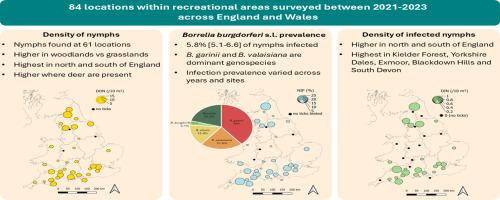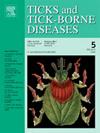An update on Borrelia burgdorferi s.l. prevalence and hazard in ticks at recreational areas in England and Wales between 2021 and 2023
IF 3.4
2区 医学
Q2 INFECTIOUS DISEASES
引用次数: 0
Abstract
Estimating tick-borne disease hazard in highly visited natural landscapes is essential for assessing public health risks. Lyme disease, caused by bacteria of the Borrelia burgdorferi sensu lato (s.l.) complex and transmitted by the tick Ixodes ricinus in Europe, is the most prevalent vector-borne disease. This study aimed to measure Lyme disease hazard across a range of recreational areas, building on previous research. From 2021 to 2023, 84 sites within 36 recreational areas across England and Wales were sampled. The density of questing I. ricinus nymphs was significantly higher in woodlands than in grasslands and significantly increased in the presence of deer. Tick density was significantly higher in the north and south of England compared to central England. The overall prevalence of B. burgdorferi s.l. in I. ricinus nymphs was 5.8 % [95 % CI: 5.1-6.6 %] (228/3914), with site-level prevalences ranging from 0 % to 30.4 %. The dominant genospecies was B. garinii (39 % of positive samples), followed by B. valaisiana (21.9 %), B. afzelii (15.4 %) and B. burgdorferi s.s. (3.1 %), which sets England and Wales apart from other European countries where B. afzelii typically dominates. The density of nymphs infected with B. burgdorferi s.l., which represents Lyme disease hazard, was significantly higher in the north and south of England compared to central England and Wales. Notably, the highest densities of infected nymphs were identified in Kielder Forest, Yorkshire Dales, Exmoor, Blackdown Hills and South Devon. We did not find any significant association between the density of infected nymphs and the presence of deer at the survey location.

2021年至2023年期间英格兰和威尔士休闲区蜱虫中的伯氏疏螺旋体流行率和危害的最新情况
在游客较多的自然景观中估计蜱传疾病危害对于评估公共卫生风险至关重要。莱姆病由伯氏疏螺旋体(Borrelia burgdorferi)复合菌引起,由欧洲的蓖麻蜱(Ixodes ricinus)传播,是最普遍的媒介传播疾病。这项研究旨在测量莱姆病在一系列娱乐场所的危害,以先前的研究为基础。从2021年到2023年,对英格兰和威尔士36个休闲区的84个地点进行了采样。在林地中,猎取蓖麻螨若虫的密度显著高于草地;在有鹿的情况下,猎取蓖麻螨若虫的密度显著增加。与英格兰中部相比,英格兰北部和南部的蜱虫密度明显更高。布氏疏螺旋体在蓖麻螨蛹中的总体流行率为5.8% [95% CI: 5.1 ~ 6.6%](228/3914),站点水平的流行率为0% ~ 30.4%。显性基因种是b garinii阳性样品(39%),紧随其后的是b valaisiana (21.9%), b . afzelii(15.4%)和b burgdorferi砂岩(3.1%),使英格兰和威尔士有别于其他欧洲国家b afzelii通常占主导地位。感染代表莱姆病危险的伯氏疏螺旋体的若虫密度在英格兰北部和南部明显高于英格兰中部和威尔士。值得注意的是,受感染的若虫密度最高的地区是基尔德森林、约克郡山谷、埃克斯穆尔、布莱克当山和南德文郡。在调查地点,我们没有发现感染若虫的密度与鹿的存在之间有任何显著的关联。
本文章由计算机程序翻译,如有差异,请以英文原文为准。
求助全文
约1分钟内获得全文
求助全文
来源期刊

Ticks and Tick-borne Diseases
INFECTIOUS DISEASES-MICROBIOLOGY
CiteScore
6.90
自引率
12.50%
发文量
185
审稿时长
6-12 weeks
期刊介绍:
Ticks and Tick-borne Diseases is an international, peer-reviewed scientific journal. It publishes original research papers, short communications, state-of-the-art mini-reviews, letters to the editor, clinical-case studies, announcements of pertinent international meetings, and editorials.
The journal covers a broad spectrum and brings together various disciplines, for example, zoology, microbiology, molecular biology, genetics, mathematical modelling, veterinary and human medicine. Multidisciplinary approaches and the use of conventional and novel methods/methodologies (in the field and in the laboratory) are crucial for deeper understanding of the natural processes and human behaviour/activities that result in human or animal diseases and in economic effects of ticks and tick-borne pathogens. Such understanding is essential for management of tick populations and tick-borne diseases in an effective and environmentally acceptable manner.
 求助内容:
求助内容: 应助结果提醒方式:
应助结果提醒方式:


